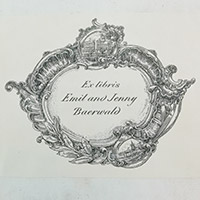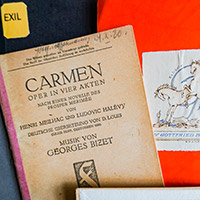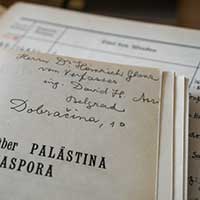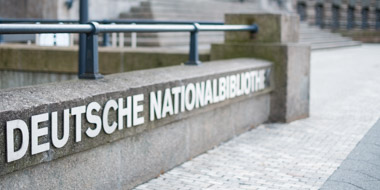Baerwald, Emil and Jenny
Emil Baerwald was born on 5 February 1869 in Frankfurt am Main; his father Herman Baerwald (1828-1907) was the director of the Philanthropin, a Jewish private school. In 1891, Emil Baerwald went to New York, where he worked as a merchant and married Jenny Dreyfus from Basel (born on 28 March 1880) in 1906. In 1925, the couple moved to Berlin but continued travelling regularly to the USA. Because of the increased persecution they experienced under the Nazi regime, Emil and Jenny Baerwald decided to return to the USA. While Jenny Baerwald was an American citizen and therefore able to travel more freely, Emil Baerwald, as a German citizen, had to apply for a U.S. visa, which he obtained through contacts at the American consulate in Berlin. He travelled to the USA in August 1938, returning to Europe once more in the autumn of that same year but without entering Germany. In the autumn of 1938, Jenny Baerwald spent a brief time in Berlin tying up their affairs in the city before the couple finally emigrated to New York at the beginning of March 1939. Emil Baerwald became an American citizen in 1944 and died in New York City in 1948; Jenny Baerwald died in 1965.

Emil and Jenny Baerwald’s bookplate was used to identify one of the books from the couple’s former private library, which was found in the collection held by the German Museum of Books and Writing. The book was purchased for the German Museum of Books and Writing in 1956 through Deutsche Buchexport GmbH at an auction held by antiquarian book dealer Gerd Rosen in West Berlin. It is not known who put the book up for auction. It was presumably confiscated after the Baerwalds emigrated and found its way into Berlin’s book trade at an unknown later date. This hypothesis is supported by a comparable copy from the same library, which was identified at the Zentral- und Landesbibliothek Berlin and returned to its rightful owners in 2018.
Thanks to close communication with provenance researchers at the Zentral- und Landesbibliothek Berlin, the German National Library was able to contact the Baerwalds’ legal successors and return the book in the summer of 2022. Before doing so, we were permitted to prepare a digitised version so that the book will still be accessible to the public in digital format.
Further information:
Bermann Fischer, Gottfried
 Photo: DNB, Laura Stein
Photo: DNB, Laura Stein
Gottfried Bermann was born in Gleiwitz (Gliwice, Upper Silesia) on 31 March 1897. He studied medicine and subsequently started his career as an assistant doctor. In 1925, he married Brigitte Fischer (born in Berlin on 5 April 1905), the daughter of Berlin publisher Samuel Fischer. At his father-in-law's request, he joined the publishing company and changed his name to Gottfried Bermann Fischer. After Samuel Fischer's death in 1934, Gottfried Bermann Fischer and his wife took over the publishing company.
Gottfried and Brigitte Bermann Fischer were both of Jewish origin. In 1935, they moved to Vienna to escape persecution by the Nazis. When they left, Gottfried Bermann Fischer succeeded in reaching an agreement with the Reich Ministry of Public Enlightenment and Propaganda regarding the division of the S. Fischer Verlag: while one part of the publishing company remained in the German Reich under the management of Peter Suhrkamp, Bermann Fischer was able to re-establish the other part in Vienna under the name "Bermann-Fischer Verlags GmbH".
In March 1938, immediately after the annexation of Austria, Bermann Fischer and his family fled via Switzerland to Sweden, where he set up the Bermann-Fischer-Verlag once more. He was forced to leave his personal possessions and the Viennese company's book depository behind when he escaped from Austria. In 1940, he was expelled from Sweden following an arrest and emigrated to the USA with his family. After the end of the war, he re-established the publishing company S. Fischer-Verlag in Berlin and Frankfurt and oversaw its operations until 1962. He died in Italy in 1995.
20 publications that formerly belonged to Gottfried Bermann Fischer have been identified from among the German National Library's holdings in Leipzig. The majority of these writings came to the Deutsche Bücherei in Leipzig in 1938/39 via the book collection and distribution centre (Bücherverwertungsstelle) in Vienna. Albert Paust, who had been seconded from the Deutsche Bücherei to the book collection and distribution centre (Bücherverwertungsstelle) in September 1938, appears to have personally supervised the removal of Bermann Fischer's private library from his apartment in Vienna's Hietzing district. In a report to the Deutsche Bücherei's Director-General, Heinrich Uhlendahl, he expressly mentions the rare private prints that he had found in Bermann Fischer's library. However, the Deutsche Bücherei was not the sole recipient of the confiscated property: the Austrian National Library in Vienna also added books belonging to Gottfried Bermann Fischer to its inventory. After the war, more books were found in the so-called "Tanzenberg collection", a depository of books looted by the Einsatzstab Reichsleiter Rosenberg. The fact that books from the private library also found their way into the antiquarian book trade is evidenced not least by the finding that two of the publications identified at the German National Library were not acquired through the book collection and distribution centre (Bücherverwertungsstelle) but were rather added to the collection as antiquarian purchases made as late as the 1960s.
The German National Library managed to contact Gottfried Bermann Fischer's heirs and, in the spring of 2023, reached an agreement with them regarding the return of the publications and their subsequent repurchase. The 20 books can thus remain in the German National Library's collection and – in accordance with the heirs' wishes – continue to be accessible to the public.
Further information:
Gottfried Bermann Fischer, Bedroht – Bewahrt. Der Weg eines Verlegers, Frankfurt am Main: Fischer Taschenbuch Verlag 1994.
Sören Flachowsky, „Zeughaus für die Schwerter des Geistes“. Die Deutsche Bücherei Leipzig 1912-1945, Göttingen 2018.
Murray G. Hall und Christina Köstner, „…allerlei für die Nationalbibliothek zu ergattern…“ Eine österreichische Institution in der NS-Zeit, Wien: Böhlau 2006.
Irene Nawrocka, „Verlagssitz: Wien, Stockholm, New York, Amsterdam. Der Bermann-Fischer Verlag im Exil (1933-1950). Ein Abschnitt aus der Geschichte des S. Fischer Verlages“, in: Archiv für die Geschichte des Buchwesens 53 (2000), S. 1-210.
Irene Nawrocka (Hrsg.), Carl Zuckmayer – Gottfried Bermann Fischer: Briefwechsel. Mit den Briefen von Alice Herdan-Zuckmayer und Brigitte Bermann Fischer, Göttingen 2004.
Grit Nitzsche, „Die Bücherverwertungsstelle Wien“, in: Regine Dehnel (Hg.), Jüdischer Buchbesitz als Raubgut. Zweites Hannoversches Symposium, Frankfurt am Main 2005, S. 67-72.
Ellenbogen, Wilhelm

Wilhelm Ellenbogen was born in Lundenberg (now Břeclav, Czech Republic) on 9 July 1863. During his childhood he and his parents and siblings moved to Vienna, where he went to school and later studied medicine. Besides being a practising physician, he was also politically active: he was a member of the Social Democratic Workers’ Party (SDAP) and was delegated to the Austrian National Council from 1918 on. During the destruction of the Social Democratic and Marxist workers’ movement in Austria by the autocratic government under Engelbert Dollfuss, Wilhelm Ellenbogen was arrested in February 1934 and released that May on condition that he ceased his political activities. Wilhelm was again arrested immediately after the “annexation” of Austria in March 1938 but was released shortly afterwards. He emigrated on 1 May 1939, first to Paris, then in October 1940 travelled via Lisbon to New York with his siblings. In New York, he joined Friedrich Adler in working for the Austrian Labor Committee. From 1946 on, he was the honorary president of the American Friends of Austrian Labor. He died in New York on 25 February 1951.
The Gestapo had already confiscated part of Wilhelm Ellenbogen’s private library in October 1938. Before his emigration, he donated the remainder of his library to the city library in Stockholm. However, the books were initially assigned to the Austrian National Library in Vienna; only after a number of diplomatic entanglements were they finally handed over the Swedish consul in Vienna in December 1939.
Wilhelm Ellenbogen’s bookplate and his personal autograph made it possible to identify five of his books in the German National Library’s collection. The accession records of the Deutsche Bücherei in Leipzig show that four of them were delivered to the library by the Bücherverwertungsstelle (book collection and distribution centre) in Vienna between December 1938 and January 1939. Coming from the same source, the fifth volume found its way into the Leipzig collection in June 1939. All of these volumes probably had belonged to the part of Wilhelm Ellenbogen’s library that was confiscated by the Gestapo in the autumn of 1938.
In the autumn of 2025, the German National Library was able to reach a just and fair solution with Wilhelm Ellenbogen’s legal successors and buy the five volumes back for the German National Library once they had been returned to their rightful owners. The Federal Archives in Berlin, who also identified one book from Ellenbogen’s former private library in their library holdings, have equally become part of this agreement. We are deeply grateful to the restitution department of the Israelitische Kultusgemeinde Wien (Jewish Community of Vienna), though whom we were able to contact Wilhelm Ellenbogen’s legal successors.
Further information:
Digital copies of two from the five restitution copies in the catalogue:
- Otto Bauer, Der blutige 15. Juli: Rede, gehalten im Nationalrat in der Sitzung am 26. Juli 1927, Wien: Organisation Wien der Sozial-Demokratischen Partei 1927
- Klaudiusz Angermann, Wohin weiter: Ökonomische Vernachlässigung Österreichs. Wien: Selbstverlag 1914
Murray G. Hall und Christina Köstner, „…allerlei für die Nationalbibliothek zu ergattern…“ Eine österreichische Institution in der NS-Zeit, Wien 2006.
Eintrag „Wilhelm Ellenbogen“, in: Wien Geschichte Wiki, zuletzt aktualisiert am 03.11.2024
Information about provenance research in the library of the Federal Archive (last retrieved on 05.12.2025)
Glanz, Heinrich

Heinrich Glanz was born in Vienna on 13 August 1891, one of the five children of the Jewish couple David and Regine Glanz, née Graeber, who originally came from Galicia. He studied law and married Selma Leitner (born on 10 October 1893), a teacher of English and French, in June 1916. He taught at Jewish schools and worked as a representative for the Jewish publishing company “Menorah” for a while. Beginning in 1923, he attempted to establish his own bookshop and publishing company, but due to his lack of training as a bookseller, he was not granted the required licence to establish a book trading and publishing business specialising in Judaica and Hebraica until 1927.
Immediately after the annexation of Austria, Heinrich Glanz was forced to close his publishing company on Gestapo orders. The publisher’s warehouse was probably cleared by the Gestapo and its contents handed over to the “Bücherverwertungsstelle” (book collection and distribution centre) in Vienna in September 1938. This authority was established by the Reich Ministry of Propaganda in Vienna to collect books confiscated from book dealers, publishing companies and private libraries and redistribute them to libraries in the German Reich.
Heinrich and Selma Glanz presumably emigrated to London in November 1938. After their arrival, Heinrich Glanz resumed his work as a book dealer and publisher, for which he may have been able to draw on publishing stocks which had been stored in Switzerland and the Netherlands and thus escaped confiscation. At the end of May 1940, they travelled by sea via Canada to the USA, where they settled in New York City. Here too, Heinrich Glanz worked as a book dealer until he was forced to give up his work on health grounds. He died in New York City in September 1958. During the 1960s, Selma Glanz, who initially worked at New York University as a French teacher, took the post of Assistant Professor at the private Jewish Yeshiva University in New York City. She died in April 1985.
A book in the holdings of the German National Library in Leipzig was identified as the former property of Heinrich Glanz due to the dedication to Heinrich Glanz written by the author on the title page. According to the Deutsche Bücherei's accession book, the item was sent to the library by the “Bücherverwertungsstelle” (book collection and distribution centre) in Vienna and was added to the collection in September 1939.
The Holocaust Claims Processing Office helped the German National Library identify the rightful heirs and established contact with the community of heirs. This enabled us to return the book to Heinrich Glanz's heirs in June 2024. They allowed us to prepare a digitised version of the book before it was returned; this can now be accessed by the public through the library catalogue.
Further information:
Jellinek-Mercedes, Raoul Fernand

Raoul Fernand Jellinek (1888-1939) was born to Emil Jellinek (1853–1918) and Rachel Gogman-Azoulay (1854–1893) in Algiers. His father was an industrialist, diplomat and businessman, who from 1898 worked as a sales consultant for Daimler vehicles. The Mercedes automobile was named after Raoul's sister Mercedes (1889-1929). In 1903, the family changed its surname to Jellinek-Mercedes. Raoul Fernand Jellinek-Mercedes married Léopoldine Weiss (1885–1981) in 1908. The couple lived in Baden, near Vienna, until 1938. Raoul Fernand Jellinek-Mercedes wrote for publications such as the “Badener Zeitung”, was a supporting member of the Wiener Musikverein (Vienna Musical Society), and possessed a library and a large collection of musical scores and paintings.
After the 'annexation' of Austria in March 1938, Raoul Fernand Jellinek-Mercedes was persecuted for being Jewish. He attempted to have himself recognised as a so-called Mischling (part-Jew), but his efforts were unsuccessful since his birth certificate contained no information about the religion of his parents and grandparents. His accounts were therefore frozen, which meant that he was repeatedly forced to sell items from his collections and private library. On 10 February 1939, he succumbed to the pressure of National Socialist persecution and took his own life. Léopoldine Weiss was forced to continue selling his property even after his death. Looking back, she described the circumstances as follows: "On 10 February, my husband shot himself after an official act by an enforcement officer. He was about to be arrested. After his death, I had to pay 32,000 RM as a Judenvermögensabgabe (Jewish asset levy). To raise this enormous amount, I had to sell the extremely valuable library, the unique collection of scores, my property in Baden, some jewellery and five very valuable Persian carpets, all at prices well under their real value." These sales led to the complete dispersal of the collection through the antiquarian book trade. In recent years, provenance research has helped identify numerous volumes in German and Austrian libraries, including 15 publications held at the German Museum of Books and Writing.
These primarily consist of seven two-part volumes of the Zeitschrift für Bücherfreunde (Journal for Book Lovers), which were acquired by Leipzig's city library in 1944. When the city library was converted into a public library at the beginning of the 1950s, it had to hand over large parts of its historical holdings to other institutions in Leipzig. The journals accordingly found their way into the collection of the German Museum of Books and Writing in 1956. In 1986, the German Museum of Books and Writing purchased another volume from the Jellinek-Mercedes collection from the antiquarian book dealer Norddeutsches Antiquariat in Rostock.
These volumes, along with 26 others, were restored to the heirs in a joint act of restitution led by the German National Library on behalf of 14 libraries from all over Germany. They were subsequently repurchased for the libraries' collections in the spirit of a just and fair solution.
Further information:
Eintrag „Raoul Fernand Jellinek-Mercedes“, in: ProvenienzWiki, 28.04.2025, URL: https://provenienz.gbv.de/Raoul_Fernand_Jellinek-Mercedes
Reinhard Brenner, Zur Geschichte der Sammlung Jellinek-Mercedes – ein Briefwechsel, in: Forum Bibliothek und Information 56 (2004), H. 5, S. 351–357.
Reinhard Brenner, Die Sammlung Jellinek-Mercedes in der Stadtbibliothek Essen, in: Regine Dehnel (Hg.), Jüdischer Buchbesitz als Raubgut. Zweites Hannoversches Symposium, Frankfurt a.M. 2006, S. 379–385.
Anett Krause und Cordula Reuß (Hg.), NS-Raubgut in der Universitätsbibliothek Leipzig. Katalog zur Ausstellung in der Bibliotheca Albertina, 27. November 2011 bis 18. März 2012 (= Schriften aus der Universitätsbibliothek Leipzig 25), Leipzig 2011, S. 58–59.
Emily Löffler, „14 Bibliotheken geben gemeinsam Bücher an die Erb*innen von Raoul Fernand Jellinek-Mercedes zurück“, in: Retour. Freier Blog für Provenienzforschende, 08.05.2025, URL: https://retour.hypotheses.org/5802
Walter Mentzel, „Raoul Fernand Jellinek-Mercedes“, in: Lexikon der österreichischen Provenienzforschung, 06.01.2019, URL: https://www.lexikon-provenienzforschung.org/jellinek-mercedes-raoul-fernand (zuletzt abgerufen am 27.03.2025).
Markus Stumpf und Mathias Lichtenwagner, „… erschoss sich mein Gatte nach einer Amtshandlung des Vollstreckungsbeamten“: Raub und Rückgabe aus der Sammlung Raoul Jellinek-Mercedes“, in: Birgit Kirchmayr und Pia Schölnberger (Hrsg.), Restituiert. 25 Jahre Kunstrückgabegesetz in Österreich (Schriftenreihe der Kommission für Provenienzforschung Bd. 9), Wien 2023, S. 344-351.
Rosenfeld, Valentin Victor

Valentin Victor Rosenfeld was born on 2 March 1886 in Vienna and was a lawyer by profession. He also volunteered for the swimming section of the Jewish sports club Hakoah Vienna. During the 1920s, his wife Eva Rosenfeld established a progressive private school, the Hietzing-Schule, in cooperation with Anna Freud and Dorothy Burlington. After the couple separated, Eva Rosenfeld and their son Victor initially moved to Berlin, where she trained as a psychotherapist. In 1936, they emigrated to Great Britain.
Following the annexation of Austria in March 1938, Valentin Rosenfeld also fled to Great Britain, from where he helped numerous members of Hakoah Vienna to emigrate. The property he left in Vienna was confiscated by the Nazis, who then assigned part of his library to the Austrian National Library (ÖNB) in Vienna. Rosenfeld’s collection of Goethe autographs was first sent to the Zentraldepot für beschlagnahmte Sammlungen (Central Depot for Confiscated Collections) then handed over to the ÖNB’s manuscript department. Other parts of his library were spread far and wide by the “Bücherverwertungsstelle” (book collection and distribution centre) in Vienna, an authority set up by the Reich Ministry of Propaganda to distribute books confiscated from Jewish book shops, publishing companies and private libraries.
Three works belonging to Valentin Rosenfeld have been found in the collection of the German National Library in Leipzig, all of which found their way into the collection of the Deutsche Bücherei in January 1939 through the Bücherverwertungsstelle (book collection and distribution centre) in Vienna. Two of the volumes contain Valentin Rosenfeld’s bookplate, while the third – a kind of school magazine from the Hietzing-Schule, a progressive school founded by Eva Rosenfeld, contains a handwritten note with the first name of their son, Victor Rosenfeld. Thanks to the Israelitische Kultusgemeinde Wien (Jewish Community of Vienna), it has been possible to establish contact with the family's heirs. The works were returned to the heirs in June 2021.
Further information:
Murray G. Hall und Christina Köstner, „…allerlei für die Nationalbibliothek zu ergattern…“ Eine österreichische Institution in der NS-Zeit, Wien 2006.
Eintrag „Valentin Rosenfeld“, in: Markus G. Patka und Ignaz Hermann Körner (Hrsg.), Lexikon jüdischer Sportler in Wien 1900-1938 (Begleitpublikation zur Ausstellung "100 Jahre Hoppauf Hakoah" des Jüdischen Museums der Stadt Wien vom 4. Juni bis 7. September 2008), Wien 2008, S. 179-180.
Karen Propp, „The Danube Maidens: Hakoah Vienna Girls‘ Swim Team in the 1920s and 1930s“, in: Susanne Helene Betz, Monika Löscher und Pia Schölnberger (Hrsg.), „..mehr als ein Sportverein“. 100 Jahre Hakoah Wien 1909-2009, Innsbruck, Wien u.a. 2009, S. 81-93, hier S. 85-86.
Information about the estate of Eva Rosenfeld in the Sigmund Freud Museum in Vienna: https://www.freud-museum.at/de/archiv (last retrieved on 23 June 2021)
Eintrag „Valentin Rosenfeld“, in: Wien Geschichte Wiki, zuletzt aktualisiert am 18. März 2021, URL: https://www.geschichtewiki.wien.gv.at/Valentin_Rosenfeld (last retrieved on 23 June 2021).
Monika Löscher, „Valentin Viktor Rosenfeld“, in: Lexikon der österreichischen Provenienzforschung, veröffentlicht am 11. Oktober 2021, URL: https://www.lexikon-provenienzforschung.org/rosenfeld-valentin-viktor (last retrieved on 02.06.2023).












